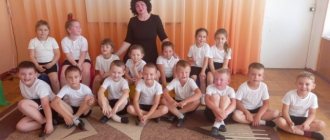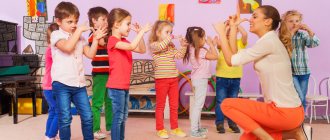Summary of the lesson in the theater studio “The Magic of Rhythm and Plasticity”
Children perform the “pat the cat” pantomime; the teacher notes the children’s successes and asks leading questions.
Teacher:
Great! Now let's release the cat. There is a snake lying in front of you now, pet it.
Next, the teacher suggests petting different animals:
- a rabbit,
- elephant,
- giraffe,
- a hamster.
Teacher:
You guys are great, who wants to share their impressions? What did you like, what was difficult to do? (children's answers)
Teacher:
We continue to develop our plasticity, and now we will try to put all our skill into our hands by doing the “Magic Hands” exercise. Imagine that you are painting a fence, your hand acts as a brush.
Children begin to perform the “Magic Hands” exercise. The teacher notes successful work and corrects the children’s work
A number of tasks are performed:
— we paint the fence: with the right hand, with the left hand, with both hands at once synchronously, with both hands towards each other;
— coordination of movement: with one hand we paint the fence, with the other we draw a “triangle”;
— rowing: on a boat, on a canoe, on a gondola;
— we wash the clothes: soak them with three soaps of soap, rinse them, wring them out and hang them up;
Teacher:
Well done! I was very interested in watching your work. Now it's time to connect the whole body, I suggest doing a little Fire-Ice warm-up. At the signal “fire” you turn into a light, cheerful, fast, bright. At the “ice” signal, you freeze in the position that caught you, while strongly tensing your muscles.
The “Fire-Ice” warm-up is carried out, the teacher monitors the correct execution.
Teacher:
Guys, now I will ask you to divide into pairs (children find a partner). Please agree who will be the leader and who will be the follower. The leader’s task is to make his partner dance, “flowing” from one pose to another.
The teacher uses his example to show how to complete the exercise, then the children begin to work independently, and after time the roles in the pair change. The teacher monitors the correct execution and helps the children.
Teacher:
Great! It was a very interesting dance! Would you like to dance now on your own, rather than being told to do so? (children's answers) Great, then I offer you the following exercise “Dancing Mirror”. I ask you to agree again which of you will be a “mirror” and which one will be a “person”. The task of the “mirror” is to repeat the partner’s dance as accurately as possible, the task of the “person is to come up with a dance in accordance with the music, I ask you to take into account each other’s capabilities.
Performing the “dance mirror” exercise, several melodies of different nature are used.
Teacher:
Thank you guys, it was a pleasure to watch your work. Please sit down in a circle. Please share what was easier for you to do and what was more difficult? (children's answers). Did you notice how much the rhythm of the music differed and how your movements changed based on this rhythm? I would be interested in trying to experiment with the rhythm, what about you? (children's answers) What do you think can set the rhythm? (children's answers) Claps, I think it's a great option! Now I will give you a rhythm, and you try to pick it up, over time I will change it.
Work program of the theater group "Dramateshka"
3. Educational:
To create conditions for the development of creative activity of children participating in theatrical activities, as well as the gradual development of various types of creativity by children.
Nurture artistic qualities, promote the development of creative potential;
Cultivating accuracy and diligence.
Nurturing children's communication abilities
The program involves one lesson per week in the afternoon. Lesson duration: 20 minutes - middle group, total number of training sessions per year - 36. 25 minutes - senior group, total number of training sessions per year - 34, 30 minutes - preparatory group, total number of training sessions per year - 34.
Theatrical activities integrate the following educational areas : _
1. EDUCATIONAL FIELD “SOCIO-COMMUNICATION DEVELOPMENT”
. Friendly relationships between children are fostered, the ability to independently unite for joint play and work, engage in independently chosen activities, negotiate, and help each other develops. Organization, discipline, collectivism, and respect for elders are fostered. Such qualities as sympathy, responsiveness, justice, and modesty are formed. Strong-willed qualities develop. Children are included in the system of social relations through the images of their heroes. They “live” the life of their character, “try on” his character, learn to evaluate the actions of the heroes of a work of fiction.
2.EDUCATIONAL AREA “COGNITIVE DEVELOPMENT”
Children's knowledge of theater as a form of art, objects of the immediate environment, natural phenomena are deepened, their horizons are expanded, which serves as material included in the content of theatrical games and exercises.
3.EDUCATIONAL FIELD “SPEECH DEVELOPMENT”
A clear, clear diction is developing, work is underway on the development of the articulatory apparatus using tongue twisters, tongue twisters, and nursery rhymes. All aspects of speech develop. The vocabulary is activated, sound pronunciation is improved, children learn to build dialogues. Through familiarization with works of art of various genres, children are introduced to verbal art and the development of literary speech.
4. EDUCATIONAL FIELD “ARTISTIC AESTHETIC DEVELOPMENT”
Emotional sensitivity, an emotional response to literary and musical works, the beauty of the surrounding world, and works of art develop.
In the process of making attributes, various types of puppet theaters, and costume elements for the fairy tale chosen for acting together with children, children develop productive activity, creative abilities, and become familiar with the fine arts.
Extracurricular activity. Theater Club.
Thematic planning of a circle lesson
"Theatrical"
| №p/p | date | Lesson topic | Contents of the activity | Educational work. | ||
| Theoretical part of the lesson (form of organization) | Practical part of the lesson (form of organization) | |||||
| 1. | Introductory lesson. | Introduce the work plan for the academic year. what is theater; how does theater differ from other forms of art? | They express their opinions and wishes. | The ability to express your opinion. | ||
| 2. | Theater game. | Articulation gymnastics. Introduce the concept of “theater play”. | Acting out the situation at the suggestion of the children. | Understand other positions, views, interests | ||
| 3. | Individual lesson. | Working on the word. Practicing individual sketches. Elimination of diction deficiencies.
| They perform various pantomimes and are able to pronounce a monologue and dialogue. | Negotiate with people, coordinating your interests and views with them in order to do something together. | ||
| 4. | Theater game. | Talk about the basic technical means of the stage about stage design about the norms of behavior on stage and in the auditorium Introduce the concept of “pantomime”, “stage miniature”. The ability to select poems about autumn. | Expressive reading of selected poems. | Cultivate a love for nature. | ||
| 5. | Theater game. | Articulation gymnastics. Introduce the concept of “theater play”. | They sing the song “Autumn has knocked on us.” | Cultivate a love for nature. | ||
| 6. | Theater game. | Articulation gymnastics. Introduce the concept of “theater play”. | Prepare drawings about autumn. They rehearse songs and poems. | Cultivate a love for nature. | ||
| 7. | Theater game. | Articulation gymnastics. Introduce the concept of “theater play”. | They rehearse songs and poems. | Cultivate a love for nature. | ||
| 8. | Celebration "Ball of Vegetables and Fruits". |
| Rhythmic, musical, plastic games and exercises. They read poetry, sing songs, and participate in competitions. | Foster collectivism. | ||
| 9. | Theater game. | Reinforce the concept of “theatrical play”. | Acting out episodes from Russian folk tales. | Instill a love of reading. | ||
| 10. | Theater game. | A selection of amateur performances. | They rehearse their numbers and know how to behave on stage. | Foster a love of creativity. | ||
| 11. | Theater game. | Articulation gymnastics. Introduce the concept of “theater play”. | Practicing amateur performances. | Foster a love of creativity. | ||
| 12. | Theater game. | Articulation gymnastics. Introduce the concept of “theater play”. | They are holding a poetry competition. | Foster a love for winter nature. | ||
| 13. | Culture and technique of speech. | Articulation gymnastics. Elimination of diction deficiencies and training of correct diction. Breathing exercises. Speech voice production. Speech in motion. Collective writing of fairy tales. Dialogue and monologue. Working on a poem and song. Learning a song about winter. Learning the skit "New Year's Tale" | They sing the song “Ice Ceiling”. | Foster a love of creativity. | ||
| 14. | Culture and technique of speech. | Articulation gymnastics. Elimination of diction deficiencies and training of correct diction. Breathing exercises. Speech voice production. Speech in motion. Collective writing of fairy tales. Dialogue and monologue. Working on a poem and song. Rehearsal of the skit "New Year's Tale" | Prepare drawings about winter. Rehearsal of songs and poems. | Foster a love of creativity. | ||
| 15. | Culture and technique of speech. | Articulation gymnastics. Elimination of diction deficiencies and training of correct diction. Breathing exercises. Speech voice production. Speech in motion. Collective writing of fairy tales. Dialogue and monologue. Working on a poem and song. Rehearsal of the skit "New Year's Tale" | Prepare decorations for your class. Rehearsal of songs and poems. | Foster a love of creativity. | ||
| 16. | Holiday "New Year's Tale". |
| They read poetry, sing songs, and participate in competitions. | Foster a love of creativity, foster collectivism. | ||
| 17. | Culture and technique of speech. | Articulation gymnastics. Elimination of diction deficiencies and training of correct diction. Breathing exercises. Speech voice production. Speech in motion. Collective writing of fairy tales. Dialogue and monologue. Working on a poem and song. The ability to choose poems about spring. | They are holding a poetry competition. | Cultivate a love for spring nature. | ||
| 18. | Culture and technique of speech. | Articulation gymnastics. Elimination of diction deficiencies and training of correct diction. Breathing exercises. Speech voice production. Speech in motion. Collective writing of fairy tales. Dialogue and monologue. Working on a poem and song. Learning a song about spring. | They sing the song “Spring Drops”. | Cultivate a love for spring nature. | ||
| 19. | Culture and technique of speech. | Articulation gymnastics. Elimination of diction deficiencies and training of correct diction. Breathing exercises. Speech voice production. Speech in motion. Collective writing of fairy tales. Dialogue and monologue. Working on a poem and song. | Round dance “There was a birch tree in the field.” | Cultivate love for native nature. | ||
| 20. | Celebration “Thank you, ABC!” |
| They sing songs, dance in circles, recite poems. | Foster collectivism. | ||
| 21. | Culture and technique of speech. | Articulation gymnastics. Elimination of diction deficiencies and training of correct diction. Breathing exercises. Speech voice production. Speech in motion. Collective writing of fairy tales. Dialogue and monologue. Working on a poem and song. Getting to know the work. | Definition of roles and distribution of roles. | Cultivate the ability to listen to each other, a love of reading. | ||
| 22. | Culture and technique of speech. | Articulation gymnastics. Elimination of diction deficiencies and training of correct diction. Breathing exercises. Speech voice production. Speech in motion. Collective writing of fairy tales. Dialogue and monologue. Working on a poem and song. Fairy tale rehearsal. | Practicing roles. | Develop memory | ||
| 23. | Culture and technique of speech. | Articulation gymnastics. Elimination of diction deficiencies and training of correct diction. Breathing exercises. Speech voice production. Speech in motion. Collective writing of fairy tales. Dialogue and monologue. Working on a poem and song. Fairy tale rehearsal. | Practicing roles and approximate staging on stage. | Develop stage presence skills. | ||
| 24. | Culture and technique of speech. | Articulation gymnastics. Elimination of diction deficiencies and training of correct diction. Breathing exercises. Speech voice production. Speech in motion. Collective writing of fairy tales. Dialogue and monologue. Working on a poem and song. Collective writing of a fairy tale. | Definition of roles and distribution of roles. | Cultivate the ability to listen to each other, a love of reading. | ||
| 25. | Culture and technique of speech. | Articulation gymnastics. Elimination of diction deficiencies and training of correct diction. Breathing exercises. Speech voice production. Speech in motion. Collective writing of fairy tales. Dialogue and monologue. Working on a poem and song. Collective writing of a fairy tale. | Definition of roles and distribution of roles. | Cultivate the ability to listen to each other, a love of reading. | ||
| 26. | Rhythmoplasty. | Communicative, rhythmic, musical, plastic games and exercises. Development of freedom and expressiveness of body movements. | Participate in games and exercises. | Develop stage presence skills. | ||
| 27. | Rhythmoplasty. | Communicative, rhythmic, musical, plastic games and exercises. Development of freedom and expressiveness of body movements. | Participate in games and exercises. | Foster a love of creativity. | ||
| 28. | Rhythmoplasty. | Communicative, rhythmic, musical, plastic games and exercises. Development of freedom and expressiveness of body movements. | Participate in games and exercises. | Foster a love of creativity. | ||
| 29. | Rhythmoplasty. | Communicative, rhythmic, musical, plastic games and exercises. Development of freedom and expressiveness of body movements. | Practicing amateur performances. | Foster a love of creativity. | ||
| 30. | Rhythmoplasty. | Communicative, rhythmic, musical, plastic games and exercises. Development of freedom and expressiveness of body movements. | Participate in games and exercises. | Foster a love of creativity. | ||
| 31. | Individual lesson. | Working on the word. Practicing individual sketches. Elimination of diction deficiencies. Script rehearsal. | Practicing amateur performances" | Foster a love of creativity. | ||
| 32. | Individual lesson. | Working on the word. Practicing individual sketches. Elimination of diction deficiencies. | Practicing amateur performances" | Foster a love of creativity. | ||
| 33. | Final lesson. Celebration “Farewell, 1st grade!” |
| Performing in front of parents. | To cultivate a love for creativity, school, and the Fatherland. | ||
Literature for teachers:
- Agapova I.A. School theater. Creation, organization, plays for productions: grades 5-11. – M.: VAKO, 2006. – 272 p.
- Belinskaya E.V. Fabulous trainings for preschoolers and primary schoolchildren. – St. Petersburg: Rech, 2006. – 125 p.
- Bogdanov G.F. Work on the musical and dance form of a choreographic work: Educational and methodological manual. Vol. 1. - M.: VTsHT (“I am entering the world of art”), 2008. - 144 p.
- Bodrachenko I.V. Theatrical musical performances for preschool children
- Buyalsky B.A. The art of expressive reading. M.: Education, 1986. –176 s.
- Vechkanova I.G. Theatrical games in habilitation of preschool children: Educational and methodological manual. – St. Petersburg: KARO, 2006. – 144 p.
- Generalova I.A. Theater. Allowance for additional education. 2, 3,4 grade. – M.: Balass, 2004. – 48 p.
- Gorbushina L.A., Nikolaicheva A.P. Expressive reading / Textbook. Benefit. – M.: Enlightenment. – 1978. – 176 p.
- Gubanova N.F. Theatrical activities of preschool children. Methodological recommendations, lesson notes, scripts for games and performances. – M.: VAKO, 2007. – 256 p.
- Gurkov A.N. School theater. - Rostov n/d: Phoenix, 2005. – 320 p.
- Additional education // Scientific and methodological journal, 2001-2009
- Zinkevich-Evstigneeva T.D., T.M.Grabenko. Games in fairy tale therapy. - St. Petersburg, Rech, 2006. - 208 p.
- Zinkevich-Evstigneeva T.D. Developmental fairy tale therapy. - St. Petersburg: Rech, 2006. – 168 p.
- Karishnev-Lubotsky M.A. Theatrical performances for school-age children. - M.: Humanitarian Publishing House. VLADOS center, 2005. – 280 p.
- Carnegie D. How to win friends and influence people: Trans. from English – M.: Literature, 1998. – 816 p.
- Kolcheev Yu.V., Kolcheeva N.M. Theatrical games at school. – M.: School press.. – 2000. – 96 p.
- Kotelnikova E. A. Biomechanics of choreographic exercises. - M.: All-Russian Central Artistic Theater ("I am entering the world of art"), 2008. - 128 p.
- Ladyzhenskaya T.A. School rhetoric: grades 4,5,6: Textbook / T.A. Ladyzhenskaya. — M.: Publishing House “S-info”; Publishing house "Balass", 2003. – 160 s.
- Lopatina A., Skrebtsova M. Tales of flowers and trees. – M.: Sphere. – 1998. – 576 p.
- Workshop of feelings (Subject “Theater” in primary school). Methodological manual. — M.: GOUDOD FCRSDOD, part 1,2. - 2006. - 56 p.
- Nesterina E.S. South Pole Chocolate: Plays. - M.: All-Russian Central Artistic Theater ("Repertoire for children's and youth theaters"), 2008. - 160 p.
- Fundamentals of acting according to the method of Z.Ya. Korogodsky. - M.: All-Russian Central Artistic Theater ("I am entering the world of art"), 2008. - 192 p.
- Pershin M.S. Fairy tale plays for the theater. - M.: All-Russian Central Artistic Theater ("Repertoire for children's and youth theaters"), 2008. - 160 p.
- Pogosova N.M. Immersion in a fairy tale. Correction and development program for children. – St. Petersburg: Rech; M.: Sfera, 2008. – 208 p.
- Popov P.G. Genre decision of the play. - M.: All-Russian Central Art Theater (“I Enter the World of Arts”), 2008. – 144 p.
- Pushkin S.I. Children's folklore theater: Plays with music supplement. - M.: VTsKhT (“I enter the world of art”), 2008. – 144 p.
- Ryleeva E.V. More fun together! – Games and work materials – M.: LINKA-PRESS. – 2000. – 144 p.
- Sakovich N.A. The practice of fairy tale therapy. – St. Petersburg: Rech, 2007. – 224 p.
- Salnikova N. Working with children: a school of trust. – SPb.: Peter. – 2003. –
282 pp.
- Skurat G.K. Children's psychological theater: developmental work with children and adolescents. - St. Petersburg: Rech, 2007. - 144 p.
- Skripnik I.S. Shadow play. – M.: AST; Donetsk: Stalker, 2005. – 221 p.
- Tannikova E.B. Formation of speech creativity of preschool children (learning to write fairy tales). – M.: TC Sfera, 2008. – 96 p.
- Tkacheva E.M. Plays. - M.: All-Russian Central Artistic Theater ("Repertoire for children's and youth theaters"), 2008. - 176 p.
- Hall D. Learning to dance. – M.: AST: Astrel, 2009. – 184 p.
- Churilova E.G. Methodology and organization of theatrical activities: Program and repertoire. — M.: Humanite. Ed. VLADOS Center, 2004. – 160 p.
- Shorokhova O.A. Playing a fairy tale: Fairytale therapy and classes for the development of coherent speech in preschoolers. – M.: TC Sfera, 2007. – 208 p.
- Yansyukevich V.I. Repertoire for school theater: A manual for teachers. — M.: Humanite. ed. VLADOS center, 2001. - 240 p.
- I explore the world: Theater: Det. encyclical/ I.A. Andriyanova-Golitsina. – M.: AST Publishing House LLC. –2002. – 445s.
Recommended reading list for parents
1. Kolcheev Yu.V., Kolcheeva N.M. Theatrical games at school. – M.: School press.. – 2000. – 96 p.
2. Monakova N.I. Traveling with the Dwarf. Development of the emotional sphere of preschool children. – St. Petersburg: Rech, 2008. – 128 p.
3. Pogosova N.M. Immersion in a fairy tale. Correction and development program for children. – St. Petersburg: Rech; M.: Sfera, 2008. – 208 p.
4. Subbotina L.Yu. Children's fantasies: Development of imagination in children. – Ekaterinburg: U-Factoria, 2006. – 192 p.
5. Skripnik I.S. Shadow play. – M.: AST; Donetsk: Stalker, 2005. – 221 p.
6. Lopatina A., Skrebtsova M. Tales of flowers and trees. – M.: Sphere. – 1998. – 576 s
Recommended reading list for children
1. I explore the world: Theater: Children. encyclical/ I.A. Andriyanova-Golitsina. – M.: AST Publishing House LLC. –2002. – 445s.
2. Kharchenko T.E. Morning exercises. Exercises for children 5-7 years old. – M.: Mozaika-Sintez, 2008. – 96 p.
3. Generalova I.A. Theater. Allowance for additional education. 2, 3,4 grade. – M.: Balass, 2004. – 48 p.
4. Carnegie D. How to win friends and influence people: Trans. from English – M.: Literature, 1998. – 816 p.
Exercises for classes in a theater club card index
Exercises to develop hand plasticity, body movements,
imagination and coordination.
"Stream"
We make wave-like movements with the hand and arm (up to the elbow), as if a stream were flowing; We depict with our hands as if we are splashing water to the sides, then on our face; wipe your face with your hands.
"Swan"
The exercise is performed with one hand, with two hands - we teach you to wave your arms, depicting a swan. Slowly raise your hand up - first comes the elbow, then the hand - fingers, then smoothly lower the hand: elbow - hand - fingers.
"Pantomimic Wall"
Starting position: feet shoulder-width apart, body relaxed. The right arm is bent at the elbow, fingers clenched into a fist. Straighten your fingers sharply, tense your palm. It is explained to the children that the hand seems to be resting against an invisible wall. We walk along an invisible wall, trying to find a way out in the wall, on the ceiling, on the floor. Gradually the room narrows: the ceiling drops, the walls move. The room turns into a small box. Now everything is gradually expanding.
"Orchestra"
We imitate playing various instruments: we “play” the piano, violin, guitar, drum, trumpet, etc. First, take turns playing each instrument, then each participant chooses an instrument for himself. At the end there should be an instrumental ensemble. The game is played to music. Without interruption, children smoothly move from one musical image to another.
"We are drawing"
a) Let's imagine that our brush is a brush. Gently dip the brush into the paint and begin to paint over imaginary walls, ceilings, and floors. Pay attention to the smooth movement of the hand.
b) Draw a picture with colored paints. Be sure to mentally imagine the drawing in color. The game is played to music.
Contact and non-contact improvisation
"Butterfly"
We move around the hall to the music, trying not to hurt anyone, but staying close to each other. On command, participants freeze in various poses, allowing one, two, four, six butterflies to be placed on themselves. For example, place the elbow of your right hand and the heel of your left foot - “places” for butterflies.
Pair exercises
"Rostock"
Goal: interaction with a partner.
Participants - plant grains - are distributed in pairs. The grains begin to germinate, branches, roots, etc. appear. The grains begin to “wrap” each other without touching the partner.
"Mirror"
Participants are divided into pairs. One of the partners is a mirror. The task of the mirror is to accurately copy and repeat the movements of the partner, being his reflection. Then the players change places.
"Sweets - tray"
A couple holds an imaginary tray of sweets. The couple's task is to carry the tray without dropping it and the sweets through rivers, mountains, holes and other obstacles.
"Wall"
In a position of stability - contact improvisation to trust a partner, the ability to distribute weight. Focus on your partner's palms. Let's hold each other.
"3 expenses"
The first is to “slide”: partners rest their foreheads on each other, evenly distributing their weight so as not to fall. The task is to slide your foreheads past each other and run in the opposite direction. The same thing, but emphasis on the shoulder, arms, hip, back, etc.
The second is to “melt”: the emphasis is the same as in the first. On command, the partners begin to melt, sinking to the floor.
The third is to “tear off sharply”: the contacts are the same. On command, the partners abruptly break away from each other and rush to opposite corners of the room.







